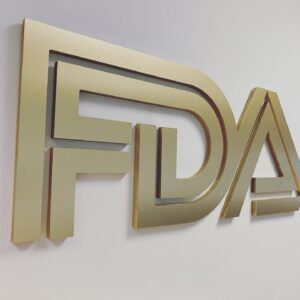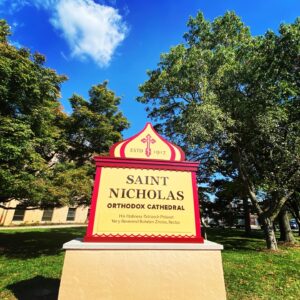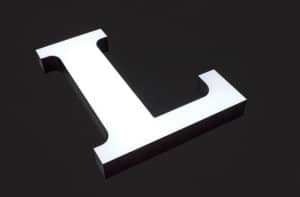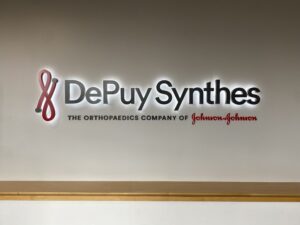Top 80 Signage Related Words – Sign Terminology
Sign Terminology
Acrylic: A clear, translucent or colored thermoplastic often used as a lightweight or shatter-resistant alternative to glass.
ADA Sign: A sign, usually a suite or bathroom sign, that meets federal standards set by the Americans with Disabilities Act.
Alumacore: A substrate with a corrugated plastic core and laminated with aluminum faces known by various brand names
Aluminum: A lightweight metal substrate used for sign panels, frames, and posts. High strength to weight ratio and highly resistant to corrosion and rust.
Aluminum Laminate: A substrate comprised of an aluminum face(s) which are laminated or bonded to acrylic or PVC.
Awning Sign: A façade mounted sign that provides additional functionality as a shelter.
Background Panel: A sign panel to which text or graphic elements are affixed.
Ballast: An electrical component required to operate fluorescent bulbs.
Banner: A lightweight and flexible sign used for temporary or short term interior or exterior applications usually comprised of digitally printed graphics on vinyl roll stock with hemmed edges and grommets for mounting.
Base Plate: A flat, thick piece of metal welded to the bottom of a sign support structure that is used for anchoring into a concrete foundation or substructure with bolts.
Bitmap: An image made up of a matrix of dots or pixels.
Braille: A system of small raised dots that represent the alphabet, punctuation and numbers for the visually impaired.
Brushed Finish: A textured non‐reflective polished finish applied to metal by lightly brushing the surface with an abrasive material.
Cabinet Sign: A sign, usually illuminated, consisting of a frame and face(s). Can be mounted to the building façade or on supports.
Carved Sign: A sign in which letters or graphic elements are incised, relieved or raised off the substrate surface. Modern carved signs are made from HDU (High Density Urethane) foam with the aid of CNC routers.
Channel Letters: Fabricated or formed three dimensional letters. Can be illuminated internally or by an exterior light source.
CMYK: Abbreviation for the ink colors cyan (blue), magenta (red), yellow and black. Combinations of these four colors are used to create the full spectrum of colors during the printing process.
Corrugated Plastic: A lightweight and cost effective substrate for temporary signs commonly referred to as Coroplast or other brand names.
Digitally Printed Vinyl Decal: Adhesive vinyl material that has been directly printed with a wide format digital printer. Typically used for complex and multicolored graphics.
Dimensional Letter: A letter, logo or symbol that is either cut, cast, molded or fabricated to create a raised condition from the mounting surface.
Direct To Substrate Printed Graphic: Printing process in which the ink is printed directly to onto the surface of the substrate.
Directional Sign: Signage that is designed to provide direction to pedestrian and vehicular traffic.
Directory Sign: A sign that identifies the names and locations of tenants in a multi‐tenant building or development comprised of multiple buildings.
Electronic Message Board: An LED (Light Emitting Diode) driven variable message sign that utilizes computer generated messages or graphics.
EPS: An acronym for Encapsulated Post Script, the common file type that vector files are saved as in order to share such file among different graphic design platforms
Exposed Neon: Neon lighting that has no protective covering or enclosure.
Exterior Illuminated: A sign that is illuminated by a light source separate from the sign that is directed onto the face of the sign.
Face: The surface area on a sign where copy or graphics can be displayed.
Face Lighted Channel Letter: An internally illuminated channel letter where the light projects through a translucent face.
Flex Face: A sign face comprised of a flexible material that is stretched over a supporting frame.
Fluorescent Lamp: Electric discharge lighting utilizing glass tubing manufactured to standard lengths.
Formed Plastic Letter: A letter, logo or symbol created by heating a sheet of acrylic or plastic until it is pliable‐ then shaped into the desired form by using a mold of the letter.
Freestanding Sign: A self supported sign that is not affixed to a building.
Halo Lighted Channel Letters: An illuminated reverse channel letter with an opaque face and open back so that the light is directed against the surface behind the letter‐ thus producing a halo lighting effect. Also referred to as silhouette or halo lit.
HDU: An acronym for High Density Urethane foam, a highly stable and consistent substrate, which is used most frequently in carved sign applications. Characterized by its resistance to splitting, cracking, weathering or rot. It is the modern substrate to replace wooden signs of the past.
Individually Mounted Channel Letters: Channel letters which are mounted separately onto the building façade. Power supplies are either remote or self contained in the letter itself.
Internally Illuminated: A sign that is illuminated by a light source that is contained inside of the sign.
Job Site Sign: A sign that announces information and project credits regarding a construction project.
JPEG: An acronym for Joint Photographic Exports Group‐ is a graphics file format designed for use with photographs and other color bitmap files.
Kerning: The process of moving letters within a word closer or further apart until the desired visual impact is achieved.
LED: An acronym for Light Emitting Diode‐ an electronic device characterized by its efficiency and long life span that emits light when electrically charged.
Lexan: A brand name for polycarbonate plastic sheeting.
Magnetic Sign: Signs that are generally used for vehicles that are comprised of vinyl graphics which have been applied to magnetic sheeting.
MDO: An acronym for Medium Density Overlay‐ an exterior grade plywood sheet that has been given a resin impregnated overlay on one or both sides to improve its paintable and finish characteristics.
Monument Sign: A freestanding sign that stands directly on the ground or ground level foundation. Usually used to mark a place of significance or entrance to a location.
Negative Space: Empty or unused space (void of copy or graphics) within a sign face. The use of negative space in balance with positive space (graphic elements) is considered by many as a basic element of good design.
Neon: Electric discharge, cold cathode tubing filled with inert glass manufactured into shapes that form letters, shapes or outlines in various colors and diameters.
Neon Channel Letter: Fabricated or formed three‐dimensional letter that uses neon as its source of illumination.
Opaque: Any material or substrate that does not allow light to pass through.
Open Face Channel Letter: A vintage style channel letter with returns that project forward from the face of letter so that internal neon tubing is visible. A clear face for physical protection of the internal components may or may not be used.
Pan Face: A sign face with returns that is either fabricated or molded into a three‐dimensional shape.
Pantone Matching System: Also known as PMS, is a standardized series of thousands of colors- each with specific color formulations and identification numbers.
PDF: Short for Portable Document Format, are files that allow the reader to view and print a document as originally designed without the need to install the original design program or fonts used to create the file.
Plaque: An inscribed commemorative plate usually made of metals such as aluminum, bronze or zinc.
Pole Sign: A freestanding sign mounted on a round pole, square tube or other fabricated member without any secondary support or frame.
Post And Panel Sign: A sign fabricated with one or more visible posts to support the sign body.
Primary Electrical: Electrical wiring that directly connects a transformer to the breaker box.
Projecting Sign: A sign that is attached to a building or wall that extends beyond the surface of the building or wall because of its perpendicular projection.
Push Through Letter: A letter or graphic which is cut out, then pushed through a corresponding space that has been removed from a sign substrate. The push through is typically different in color and material from the rest of the sign. Generally used with an internally illuminated opaque sign cabinet with translucent push through letters.
PVC: Short for Polyvinyl Chloride‐ the third most widely produced plastic in the world. PVC is a widely used substrate known for its durability, versatility and cost effectiveness. Commonly referred to by the brand names Sintra or Komatex.
Raceway: A fabricated metal structure that serves as a mounting surface for illuminated channel letters. Electrical components are generally enclosed within the raceway. The advantages of the raceway is the speed/ease of installation and less intrusive anchoring onto the building façade.
Retainer: A framing member mounted around the perimeter of a sign face and attached to the sign cabin.
Retractable Banner Stand: A collapsible and highly portable freestanding display comprised of a retractable digitally printed vinyl graphic with an sleek aluminum stand enclosure.
Reveal: An indented detail on a sign.
Reverse Channel Letter: Sometimes referred to as “halo letters” – fabricated dimensional letter with opaque face and returns. The lighting source appears behind the letter to create a “halo” effect.
Routed Face: Elimination of material in a substrate in which the negative space is opaque, while the copy is illuminated. This type of sign is primarily used with aluminum faces backed by translucent acrylic.
Sandblasted Sign: A dimensional sign in which a pressurized stream of sand is used to texture the surface. Modern techniques use CNC routers to simulate the sandblasted texture.
Satin Finish: Refers to a smooth finish characterized by the absence of high gloss or shine.
Seam: A line formed by joining together two separate pieces of the same or different materials at their edges.
Standoffs: Decorative machined aluminum hardware used to mount sign panels onto walls.
Step Stake: Basic steel wire supports used to install corrugated plastic signs into the ground.
Stud Mounted: An installation technique for letters and sign panels in which the signage is mounted via hidden threaded studs.
Substrate: The material from which a sign panel is made. Acrylic, PVC, aluminum, and MDO are all examples of substrates.
Tactile Copy: Raised lettering typically found on ADA signs on which they are required.
Temporary Sign: Any sign not intended for permanent installation‐ such as banners, real estate signs, site signs or political signs.
Transformer: An electrical component that changes the voltage coming into the sign (primary voltage) into a higher or lower level (secondary voltage) necessary to power the sign.
Translucent: A characteristic that allows the passage of some light through the material.
U‐Channel Post: A standardized steel post with pre‐drilled holes for easy sign installation.
Vector File: A graphics file comprised of points, lines, and coordinates which can be scaled to a larger size without the loss of any image quality.
Vinyl Graphics: Graphics that are computer cut from adhesive backed pigmented vinyl in standard colors of opaque, translucent, or metallic finishes.
Wall Sign: A sign that is attached flush onto a building and can only be viewed from one side.
Wayfinding: Enabling a person to find his or her way to a given destination through the use of effective signage.
Weep Hole: A strategically placed hole or small opening at the bottom of a letter or sign cabinet to prevent water from accumulating.
Wood Grain: A technique used on carved HDU signs in which the CNC router simulates the grain of natural exposed wood.




